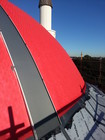- 267-263-2308
- info@uspunderlayment.com
Synthetic Underlayments: Leading-Edge Technology Taking Hold As Architects And Contractors Learn of Benefits
By Sal Catanese
Synthetic underlayment can best be described as one of the newest members of a generation of high tech, high performance underlayment alternatives. They can be used under shingles, tiles, slate, metal or cedar shakes and synthetic roof claddings. In cases of unforeseen severe weather conditions and construction delays, the installed product, can be left uncovered for months and still maintain their leak-proof status. They will retain their resistance to water even after long-term exposure to UV rays and extreme heat.
Sound too good to be true? A closer look into the composition of these new synthetic underlayments and further details on the product's benefits may help convince you to give this new "miracIe materiaI" a closer look.
Most synthetic underlayments are polymer-based polyethylene or polypropylene woven or spun·bound heavy laminanates. Polymers are substances whose molecules have high molar masses and are composed of a large number of repeating units.
Polyethylene is perhaps the simplest polymer. There is a high-density poIyethyiene (HDPE) and low-density polyethylene (LDPE) used in some synthetic underlayments. HDPE is hard and resilient and is used in the manufacture of containers such as milk jugs and laundry detergent bottles. LDPE is relatively soft and used for the production of the kind of plastic films used in sandwich bags.
Another polymer type used in these new roofing underlayments is polypropylene. Polypropylene (PP) is slightly more brittle than polyethylene, but softens at higher temperatures. Polypropylene is used extensively in the automotive industry for interior trim such as instrument panels.
Onto the top of the product is added an anti-slip coating, or layer of material which is also laminated. This enhances the skid-resistant properties of the underlayment materials, making them a very safe surface for contractors to walk on. Our company's RoofTopGuard II synthetic underlayment features a Fiber Grip surface, making it one of the most slip-resistant and safest of all underlayment surfaces . Other synthetic underlayment products have their own versions of a skid-resistant surlace.
Architects who have worked with heavy roofing materials in the past should pay particular attention to the extreme low weight of these materials. It makes it very easy for application crews to transport and install. A ten square roll of synthetic underlayment usually weighs less than 45 Ibs. Compared to felt underlayment at approximately 260 Ibs. for ten squares, these products could be heaven sent for the architect to specify.
Contractors report that their crews adapt easily to working with these materials and find that application times are two to three times faster than with felt papers. Synthetic materials are very rugged and resist damage during installation. Most are easy to cut and mold around corner. Some products such as RoofTopGuard seal around cap nails and penetrations to prevent leaks when installed properly and left exposed.
It will not promote the growth of mold and because it does not absorb water, it prevents the occurrence of waves or humps which may affect the final appearance of some roofing mate rials. And it only costs pennies more per square foot than traditional felt underlayments.
Still skeptical? Consider this: Contractors in various areas of the United States tell us they can install synthetic underlayments such as ours in record times. One six_person crew reportedly installed 10,000 sq. ft. of RoofTopGuard on a 6:12 pitch in four hours.
And this: Despite the conditions, underlayments installed on several hundred jobs prior to the hurricanes in Florida in 2004 were still on and protecting their roof decks long after the storms had passed. The superior shear force and resistance to tearing allowed these materials to stay on where others gave up and blew out to sea. When Mother Nature sends her worst, synthetic underlayments are at their best.
Although it is human nature to resist change, it is hard to deny the advantages uf synthetic underlayments. If you think it all sounds too good to be true, consider once again this product type's primary benefits:
With its multi-layer polypropylene and polyethylene composition, synthetic underlayments provide strength, light weight, and tear resistance and longer life than almost any product.
Although fairly new to the United States, the materials' basic components are products that have been proven in the harsh climates of northern Europe and Canada for over 25 years.
Synthetics perform better when tested against traditional underlayments, particularly when subjected to high winds, insects, vermin, rot and fungus.
Its low weight allows for faster, easier and more secure installation.
Superior strength means no more job repair worries from tears and holes.
Synthetics are approximately six times lighter than 30# felt paper and much stronger.
They contain no asphalt and will not disintegrate under the roof covering even after years of use. It will remain effective and useful.
Go ahead; challenge yourself and your customers to this new technology. I think you'll find it lives up to its excellent reputation and I promise you won't be disappointed.




